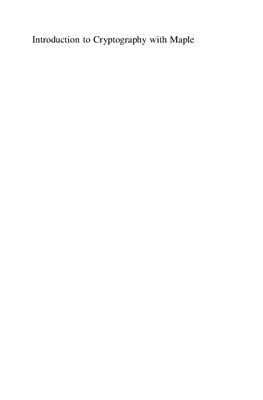Springer, 2013. - 725 p., English, ISBN-10: 3642321658 - PDF, 10,7
MB. (+ дополнительные материалы с сайта поддержки - source code,
errata, e.t.c.)
This introduction to cryptography employs a programming-oriented
approach to study the most important cryptographic schemes in
current use and the main cryptanalytic attacks against them.
Discussion of the theoretical aspects, emphasizing precise security
definitions based on methodological tools such as complexity and
randomness, and of the mathematical aspects, with emphasis on
number-theoretic algorithms and their applications to cryptography
and cryptanalysis, is integrated with the programming approach,
thus providing implementations of the algorithms and schemes as
well as examples of realistic size.
A distinctive feature of the author's approach is the use of Maple
as a programming environment in which not just the cryptographic
primitives but also the most important cryptographic schemes are
implemented following the recommendations of standards bodies such
as NIST, with many of the known cryptanalytic attacks implemented
as well. The purpose of the Maple implementations is to let the
reader experiment and lea, and for this reason the author
includes numerous examples. The book discusses important recent
subjects such as homomorphic encryption, identity-based
cryptography and elliptic curve cryptography. The algorithms and
schemes which are treated in detail and implemented in Maple
include AES and modes of operation, CMAC, GCM/GMAC, SHA-256, HMAC,
RSA, Rabin, Elgamal, Paillier, Cocks IBE, DSA and ECDSA. In
addition, some recently introduced schemes enjoying strong security
properties, such as RSA-OAEP, Rabin-SAEP, Cramer-Shoup, and PSS,
are also discussed and implemented. On the cryptanalysis side,
Maple implementations and examples are used to discuss many
important algorithms, including birthday and man-in-the-middle
attacks, integer factorization algorithms such as Pollard's rho and
the quadratic sieve, and discrete log algorithms such as baby-step
giant-step, Pollard's rho, Pohlig-Hellman and the index calculus
method.
This textbook is suitable for advanced undergraduate and graduate
students of computer science, engineering and mathematics,
satisfying the requirements of various types of courses: a basic
introductory course; a theoretically oriented course whose focus is
on the precise definition of security concepts and on cryptographic
schemes with reductionist security proofs; a practice-oriented
course requiring little mathematical background and with an
emphasis on applications; or a mathematically advanced course
addressed to students with a stronger mathematical background. The
main prerequisite is a basic knowledge of linear algebra and
elementary calculus, and while some knowledge of probability and
abstract algebra would be helpful, it is not essential because the
book includes the necessary background from these subjects and,
furthermore, explores the number-theoretic material in detail. The
book is also a comprehensive reference and is suitable for
self-study by practitioners and programmers.
Pardo José Luis Gómez. Introduction to Cryptography with Maple (+ дополнительные материалы с сайта поддержки)
- формат archive, html, maple, pdf
- размер 10,47 МБ
- добавлен 01 сентября 2013 г.

Похожие разделы
